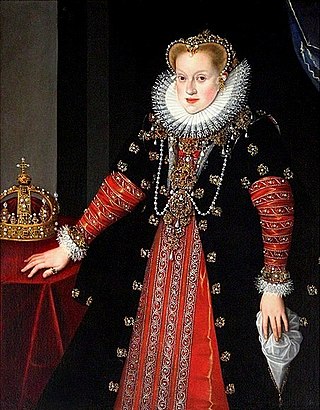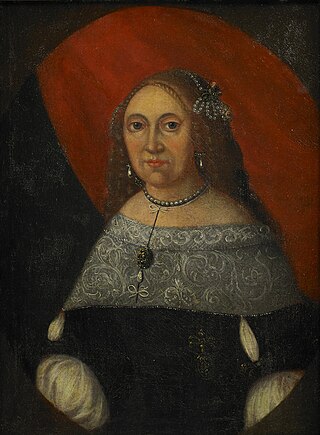Related Research Articles

Anne of Austria was Queen of Poland and Sweden and a Grand Duchess of Lithuania as the first consort of King Sigismund III Vasa.

Sophia Magdalena of Denmark was Queen of Sweden from 1771 to 1792 as the wife of King Gustav III.

Catharina Ebba Horn af Åminne,, was a Swedish noble and the second official royal mistress of King Frederick I of Sweden from 1745 to 1748. She was one of two official royal mistresses in Sweden. She had no influence over state affairs, but she did patronise careers through her powerful connections and her position.

Countess Christina Augusta Löwenhielm, was a Swedish noblewoman and courtier. She is known for her love affair with the later Charles XIII of Sweden. She is also famous in history as one of "the three graces" of the Gustavian age; three ladies-in-waiting immortalized in the poem Gracernas döpelse by Johan Henric Kellgren, and known profiles of the epoch.

Margareta Eriksdotter Vasa, also called Margareta Vasa and Margareta of Hoya, was a Swedish noblewoman, sister of King Gustav I of Sweden. Between 1525 and 1534, she commanded Vyborg Castle on several occasions during the absence of her spouse.

Margareta Abrahamsdotter Brahe was a Swedish aristocrat and court official, Landgravine of Hesse-Homburg by marriage to Frederick II, Landgrave of Hesse-Homburg. She aroused a lot of attention with her marriages, which were considered scandalous.
Elizabeth Ribbing, was a Swedish noblewoman and lady-in-waiting. She was the secret morganatic spouse of Prince Charles Philip, Duke of Södermanland.

Eva Helena Löwen, was a politically active Swedish countess and royal favorite. She was active as a French agent in Sweden.
Fredrika Eleonora von Düben was a Swedish dilettante painter and embroidery artist
Elisabet Juliana Banér, was a German noble, married to the Swedish Field Marshal Johan Banér in 1636. She is considered to have wielded a certain influence upon Banér and the Swedish army during the Thirty Years' War.

Charlotta Fredrika Sparre, commonly named Lotta Sparre, was a Swedish noble and courtier.

Adolph Ludvig Ribbing, later called Adolph de Leuven, was a Swedish count and politician. He participated in the regicide of Gustav III of Sweden in 1792.
Gese Wechel, was the managing director of the Swedish Post Office, Postverket from 1637 until 1642. She was the second director of the Swedish Post Office, and the first female postmaster in Sweden, entitled Sveriges rikes postmästarinna.
Johanna "Jeanna" von Lantingshausen, née von Stockenström, (1753–1809), was a Swedish noble and courtier. She is foremost known as the instigator of the political demonstration by the noblewomen toward Gustav III in opposition of his parliamentary act of 1789.
Caroline Lewenhaupt (1754–1826) was a Swedish courtier, poet and amateur actress.
Elizabeth Carlsdotter Gyllenhielm, was the daughter of the Swedish prince Charles Philip, Duke of Södermanland, in his secret marriage with the noble Elizabeth Ribbing.
Karin Göransdotter Gyllenstierna was a Swedish courtier. She served as Chief Court Mistress to queen Catherine Jagellon and, after her death, to Princess Anna Vasa of Sweden.

Elsa Elisabeth Brahe, was a Swedish countess and duchess, married to Adolph John I, Count Palatine of Kleeburg, Duke of Stegeborg, the brother of king Charles X of Sweden.

Events from the year 1639 in Sweden

The Düben family is a Swedish family originally from Saxony, Holy Roman Empire, whose members were elevated to the Swedish nobility, that rose to prominence with Andreas Düben, an organist to the German Church in Stockholm, Swedish Empire.
References
- Wilhelmina Stålberg, P. G. Berg : Anteckningar om svenska qvinnor
- Gustaf Elgenstierna, Den introducerade svenska adelns ättartavlor. 1925-36.
- Nils Gabriel Djurklou: Lifvet i Kinds härad (1885)